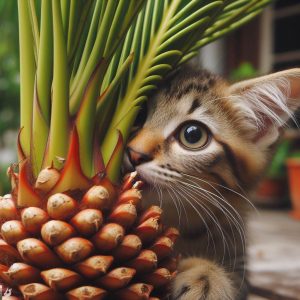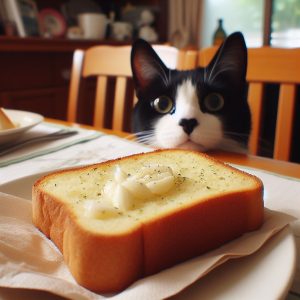As a cat owner, you’ve likely experienced your furry feline friend licking your morning cereal bowl after you’ve finished, helping themselves to a taste of your ice cream cone, or sticking their tongue in your water glass when you’re not looking. While these antics may seem harmless, it leaves many cat parents wondering: Is it actually safe for me to eat or drink from something my cat has licked?
This common cat behavior can spark some uncertainty around sharing food and drinks with our curious kitties. Can their tongues transfer bacteria or illnesses? Should you be worried, or is it perfectly fine as long as you don’t see any obvious cat hairs floating in your drink?
To help put owners’ minds at ease (and avoid needlessly throwing out perfectly good food), this article will dive into the risks and precautions regarding consuming cat-licked eats. We’ll explore some of the science and veterinary guidance around cats’ mouths and illnesses, when you should be concerned, and tips to stop the licking behavior. Read on for the key facts and advice you need to make informed decisions about sharing food and drink with feline friends.
Should You Actually Be Concerned About Eating Cat-Licked Food?
Before understanding if cat licks make food unsafe for human consumption, it helps to first explore why cats lick things in the first place. Our furry companions use their rough tongues for many purposes:
- Grooming. Have you ever watched your cat lick their leg for 20 minutes straight? Cats lick themselves to distribute natural oils in their fur and keep their coats clean and mat-free, like a hairbrush.
- Cooling down. Since cats only have sweat glands on their paw pads, they can’t cool themselves by sweating like humans. Instead, saliva spread over their fur helps facilitate evaporative cooling.
- Healing wounds. Cat saliva contains enzymes and proteins that help clean and disinfect minor scratches, bites, or injuries. Licking is like nature’s antiseptic for cats!
- Investigating objects. Cats use their tongue like another sensory organ to analyze interesting items in their environment. A lick provides chemical information about food, water, or other objects.
- Social bonding. Some cats will lick their human owners as a sign of affection, similar to social grooming between cat friends.
As you can see, in most cases, cats lick things simply to clean themselves, explore, or show affection. Their tongues are not crawling with germs aiming to spread illness at the dinner table. In fact, thanks to antibacterial compounds in saliva, cat licks even help disinfect minor wounds.
However, experts acknowledge there are some disease risks that warrant careful consideration before eating or drinking after your cat.
Potential risks of consuming cat-licked food or drinks:
- Bacterial contamination: While cat saliva is somewhat antibacterial, cats groom themselves frequently enough that bacteria from their fur and environment still enter their mouths. These could potentially be transferred to human food.
- Parasitic infections: Outdoor cats who hunt small prey are at higher risk of picking up certain parasitic organisms like toxoplasmosis or giardia. In theory, these parasites could be passed to humans through licked food.
- Allergic reactions: People with cat allergies can react to the allergenic proteins from cat dander and saliva left behind on food or dishware.
- Foodborne illnesses: Bacteria like salmonella or E. coli could be transmitted from a cat’s unwashed paws, litter boxes habits, and environmental exposures.
So while a cat lick is typically harmless between friends, there are some valid health considerations before eating food or drinking from containers “tainted” by a cat tongue. The actual level of risk depends on several factors:
- Your cat’s general health and veterinary care
- Whether your cat goes outdoors
- The type of food or drink involved
- Your own health sensitivities
Later in this article, we will explore actionable steps you can take to minimize risks when sharing food and home with felines. But first, let’s dive deeper into the types of hazards that may lurk in kitty licks.
Bacteria Carried in Cat Saliva and Mouths
Because cats use their tongues for self-grooming, their mouths inevitably contain higher levels of bacteria compared to relatively sterile human mouths. However, how hazardous are these bacteria really?
Research indicates the main organisms found in cat saliva are similar to what’s present in human saliva, typically posing minimal risks. Studies have detected bacteria like:
- Pasteurella – Common respiratory bacteria. Usually not harmful except in immunocompromised people or serious wounds.
- Streptococcus – Found in human mouths. Can cause skin infections but mild.
- Neisseria – Common bacteria that lives harmlessly in throats and noses.
- Actinomyces – Responsible for dental plaque. Not serious except in bloodstream infections.
- Capnocytophaga – Linked to rare illnesses like septicemia, but primarily in those with weakened immune systems.
So while many types of bacteria live in cats’ mouths, most are common environmental microbes that pose low risks, especially to healthy individuals. Proper cooking and food handling provide additional protection against contaminants.
However, cats may sometimes carry more dangerous pathogens requiring caution:
- Salmonella – Causes serious food poisoning. Transferred from raw food diets or litter boxes.
- Campylobacter – Also causes gastrointestinal illness. More common in outdoor cats.
- E. coli – Poses foodborne illness risks from undercooked meats.
- Yersinia – Causes fever, cramps, vomiting in humans. From sick prey.
- Bartonella – Linked to cat scratch disease and fever. Outdoor cats at most risk.
For these reasons, it’s smart to take extra care around raw meats, dairy, and other perishable foods that cats may lick before proper cooking. Later, we will cover specific tips to minimize bacterial risks from cat licks when preparing or serving foods.
Dangers of Parasites in Cat Saliva
In addition to bacteria, one of the top concerns around cat-licked food is the potential for transmitting parasitic organisms. Some key parasites to consider include:
Toxoplasmosis
- Caused by the Toxoplasma gondii parasite
- Found in undercooked meat and contaminated soil
- Usually only risky for pregnant women (can harm unborn babies)
- Also a concern for those with compromised immunity
Giardia
- Microscopic Giardia intestinalis parasite
- Results in “beaver fever” diarrhea/cramps in humans
- Spread through contaminated water or surfaces
Fleas
- Cat fleas (Ctenocephalides felis) feed on cat and human blood
- Fleas transmit other parasites and diseases in their feces
- Not directly transmitted through food, but close contact allows bites
The chances of catching a parasitic infection from food contamination increases if your cat goes outdoors and hunts prey frequently. This exposes them to more parasites which could then be introduced to your home.
However, indoor cats who don’t consume raw meat are unlikely to harbor these parasites. Your vet can test your cat’s stool at their annual wellness exam to check for any gut parasites. This provides peace of mind that your beloved kitty isn’t hosting any creepy crawlers that could get passed through their licks!
Allergy Risks from Cat Licks
While not infectious, cat allergies are another consideration with cat-licked food. It’s estimated around 10% of people are allergic to cats.
Allergies are caused not by cat hair itself, but by specific proteins found in cat dander (shed skin), saliva, and urine. These proteins trigger immune reactions in sensitive individuals when entering the body, causing symptoms like:
- Runny nose, itchy eyes
- Wheezing, coughing, chest tightness
- Rash, itchiness, skin redness
- Vomiting, diarrhea (in severe cases)
If you have a known cat allergy, exposure to even small amounts of cat saliva on utensils, rims of cups, or food could cause a reaction. The closer the contact, the higher the risks.
However, thorough handwashing and cleaning of dishes can help remove all traces of cat dander and saliva allergens after a cat has licked them. Taking antihistamines prior to eating may also reduce reactions.
Tips to Minimize Health Risks of Eating Cat-Licked Foods
Now that we better understand the potential (although rare) risks of illness from cat licks, here are some tips to minimize dangers when sharing food and drinks with your furry feline friend:
1. Consider your cat’s health and lifestyle.
Regular veterinary care, vaccines, deworming, and an indoor lifestyle lower your cat’s risks of transmitting diseases enormously. Kitties who roam outdoors or eat raw diets warrant more caution.
2. Avoid high-risk soft foods.
Moist foods your cat can sink their teeth into pose more risks than hard, impervious snacks. Be extra cautious with soft cheeses, deli meats,custards, ice cream, whipped cream, and brothy soups.
3. Visually inspect foods and drinks.
Check for any visible cat hairs, dirt from paws, or wet saliva residue left behind. When in doubt, throw it out.
4. Remove contacted surfaces.
In solid foods, scrape off any parts your cat’s tongue actually touched. With soups or drinks, discard a couple inches from the rim they licked.
5. Wash produce thoroughly.
Rinse fruits and veggies under running water to wash away saliva and debris.
6. Microwave high-risk foods briefly.
Microwaving for 30 seconds to 1 minute can help kill any bacteria on the outer surface of moist foods your cat licked, like leftover meatloaf or tuna casserole. Just stir occasionally as food heats.
7. Use sanitizing kitchen cleaners.
Disinfect any dishes, utensils, and surfaces your cat contacted using veterinarian-recommended cat-safe disinfectants. Chlorhexidine and benzalkonium chloride effectively kill bacteria and viruses when used as directed.
8. Apply the sniff test.
If food still smells and looks fine after a minor cat lick, it’s likely safe to consume. But if the food took on a hairball-esque odor or appearance, that’s your cue to toss.
9. Wait before eating.
If practical, let some time elapse between your cat licking the food and yourself eating it. An hour or two allows any pathogens to die off.
10. Seek treatment for concerning symptoms.
Promptly contact your doctor if you develop fever, vomiting, rash, or other worrying symptoms after consuming cat-licked foods or drinks. Medications can treat conditions like salmonella and giardia early on before they become severe.
High-Risk Foods to Toss Out if Licked by Cats
While taking basic precautions allows enjoying most cat-licked treats, some foods carry risks that are too hazardous to mess around with. Always discard and throw out the following foods if licked extensively by your cat:
- Raw meat, fish, eggs, and poultry
- Soft cheese, cream cheese, queso, brie
- Leftover potato, pasta, or fruit salads
- Infant formula, milk, or pureed baby foods
- Any perishable food needing refrigeration
- Any food if you have a weakened immune system
The bacteria risks outweigh the benefits with these foods. When in doubt, throw it out to stay on the safe side!
Training Techniques to Stop Cats From Licking People Food
The best way to eliminate concerns about cat licks in your food is to stop the behavior at the source. Use these training techniques to teach your cat not to lick human edibles:
- Say a firm “No” or loud noise when catching kitty licking food or drinks. Be consistent so they associate the sound with the undesired behavior.
- Block access to tables and counters using boxes, double-sided tape, tin foil, or other deterrents. This removes temptation.
- Feed cats before human mealtimes so they are not as interested in stealing human food. A full tummy lessens food-seeking behavior.
- Try bitter anti-lick sprays on surfaces. Cats hate the taste of citrus, mint, and bitter apple.
- Use motion sensor pet deterrents like Ssscat compressed air sprayers. They blast surprising (but harmless) air when cats get too close to the kitchen.
- Divert and distract with toys or play when cats approach off-limit zones. Get them immersed in an exciting game instead.
- Reward with treats when your cat leaves an area without trying to lick food. Positive reinforcement works wonders!
With patience and consistency, you can definitely train your curious cat not to steal precious licks of people food. Removing access, rewards, surprises, and diversion are the keys to success.
Seeking Veterinary Care After Consuming Cat-Licked Food
Hopefully this article has shown that the risks from cat licks are minimal with basic precautions. But do contact your doctor and veterinarian right away if you experience any of the following after eating cat-licked food:
- Fever, headache, body aches
- Nausea, vomiting, diarrhea lasting over 48 hours
- Fatigue, muscle weakness, numbness or tingling
- Cough, difficulty breathing
- Rash, itchy skin, hives
- Confusion, vision changes, trouble walking
While rare, these could indicate a more serious illness like salmonella, cat scratch fever, or toxoplasmosis. Prompt medical treatment is needed. Anti-parasitic medications, antibiotics, intravenous fluids, pain relievers, and other interventions can swiftly address conditions acquired from cats before they progress.
In the unlikely case your cat also falls ill, your vet can provide medications, lab testing, and supportive care to nurse them back to health. With quick vet care, most kitty-to-human transmitted diseases are very treatable.
The Takeaway: Balancing Food Safety With Feline Bonding
Hopefully this guide has shown that most cat licks are completely harmless, especially from indoor cats up-to-date on veterinary visits. While certain precautions are smart around high-risk foods, you do not need to panic or throw away your dinner after every cat tongue tap.
With sensible cleaning methods, avoiding the riskiest foods, proper cooking, and training cats not to steal licks in the first place, you can safely share your home (and meals!) with your treasured tabby. A few basic precautions go a long way to prevent illness while preserving the special bond with your feline friend.
So snuggle up and toast with your cat to a long, healthy life together. Just be sure to keep your morning cereal bowl a little further from the edge of the table!



